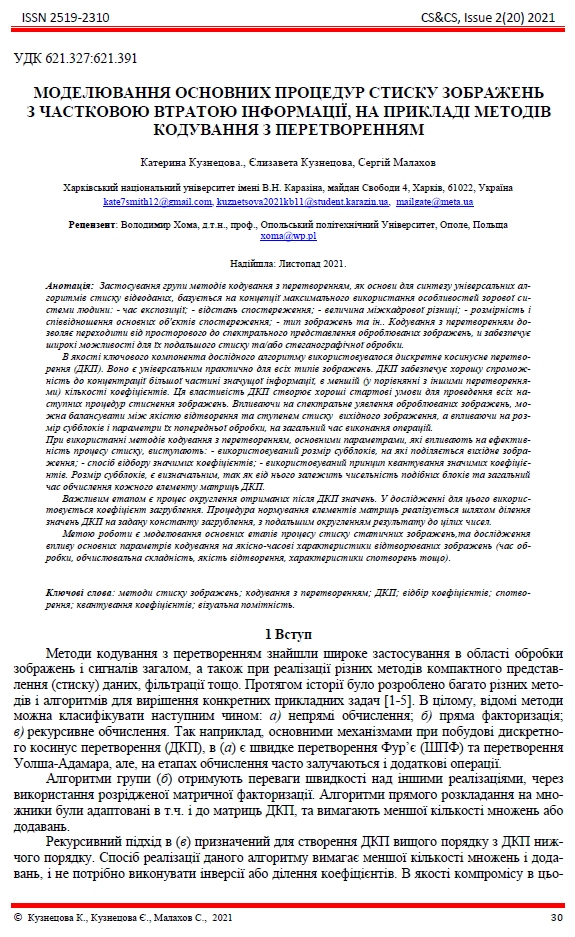Modeling of basic image-lossy compression procedures using transformation coding methods, as an example
Abstract
Using the set of transformation coding methods as the ground to synthesize of universal video compression algorithms is based on using the features of the human visual system: - exposure time; - observation distance; - the value of the interframe difference; - dimension and ratio of main observed objects; - type of images, etc. Transform coding allows transiting from spatial to spectral representation of the processed images and provides ample opportunities for their subsequent compression and/or steganographic processing. The main component of the research algorithm is the discrete cosine transform (DCT). It is universal for almost all types of images. DCT provides a good ability to concentrate most of the relevant information in a smaller (compared to other transformations) number of coefficients. This DCT property creates good initial conditions for all the following image compression procedures. By influencing the spectral representation of the processed images, it is possible to balance between the reproduction quality and the degree of compression of the original image, and by influencing the size of the sub-blocks and the parameters of their preprocessing, it is possible to reduce the total time of operations proceed. When using transform coding methods, the main parameters affecting the efficiency of the compression process are: - the used size of the sub-blocks into which the original image is divided; - the method of selecting significant coefficients; - the used principle of quantizing important coefficients. The size of the sub-blocks is decisive, since the number of such blocks and the total computation time for each element of the DCT matrices depend on it. An important step is the rounding process of the values obtained after DCT. The study uses a coarsening factor for this. The procedure for normalizing matrix elements is implemented by dividing the DCT values by a given coarsening constant, followed by rounding the result to the integer numbers. The aim of the work is to simulate the main steps of the compression of static images and study the influence of the main coding parameters on the qualitative and temporal characteristics of the reproduced images (processing time, computational complexity, reproduction quality, distortion characteristics, etc.).
Downloads
References
N. Chelemal-D and K. R. Rao // Fast computational algorithms for the Discrete Cosine Transform // 9th Annual Asilomar Conf. on Circuit, Systems and Computers, Pacific Grove, CA, Nov. 1985.
Красильников Н.Н. Статистическая теория передачи изображений. - М.: Связь, 1976. – 184 с.
Прэтт У. Цифровая обработка изображений. т. 1,2. - М.: Мир, 1985. - 736 с.
Зубарев Ю.Б., Дворкович В.П. Цифровая обработка телевизионных и компьютерных изображений. - М.: МЦНТИ, 1997. – 212 с.
Королев А.В. Оценка информативности трансформант дискретного косинусного преобразования. Системи Обробки Інформації. 2003. № 3. С. 81-86.
About JPEG // Електронний ресурс. Режим доступу – http://www.pcs-ip.eu/index.php/main/edu/5.
Morozov, D., Shaforostov, M., Malakhov, S., & Serbin, V. (2018). Подвійна обфускація трансформант малоресурсного стеганоалгоритма. Комп’ютерні науки та кібербезпека, 9(1), 22-34. вилучено із https://periodicals.karazin.ua/cscs/article/view/12015
Гончаров М. О. Дослідження процедур попередньої підготовки вихідних даних для стеганоалгоритма. Сучасні напрями розвитку інформаційно-комунікаційних технологій та засобів управління: матеріали 11-ї міжнар. наук.-техн. конф., 8–9 квіт. 2021 р. м. Баку–Харків–Київ–Жиліна. т. 2. с. 63. URL: http://repository.kpi. kharkov.ua/handle/KhPI-Press/52020 (дата звернення 1.05.2021).
Рубан И. В., Клименко Л. А. Сжатие видеоданных длинами серий с загрублением цвета. Информатика. Киев: Наукова думка, 1998. № 5. С. 44-48.
The Discrete Cosine Transform // Електронний ресурс. Режим доступу – https://users.cs.cf.ac.uk/Dave.Marshall/Multimedia/node231.html
Кузнецов О. О., Полуяненко М. О., Кузнецова Т. Ю. Приховування даних у частотній області нерухомих зображень на основі кодування різниці абсолютних значень коефіцієнтів дискретного косинусного перетворення // Методичні рекомендації.
Мастрюков Д. Краткое объяснение JPEG и его реализации. Алгоритмы сжатия информации. Часть 7. Сжатие графической информации.
Kasperovich L.V. Multiplication free scaled 8 x 8 ДКП algorithm with 530 additions // Електронний ресурс. Режим доступу – https://www.spiedigitallibrary.org/conference-proceedings-of-spie/2419/0000/Multiplication-free-scaled-8-x-8-ДКП-algorithm-with-530/10.1117/12.206390.full?SSO=1.
Douglas A. Kerr // Chrominance Subsampling in Digital Images // Електронний ресурс. Режим доступу – http://dougkerr.net/Pumpkin/articles/Subsampling.pdf.
Hou H. A Fast Recursive Algorithm For Computing The Discrete Cosine Transform // Електронний ресурс. Режим доступу – https://www.researchgate.net/publication/3235321_A_Discrete_Fourier-Cosine_Transform_Chip.


